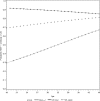Prevalence of toxic shock syndrome toxin 1 (TSST-1)-producing strains of Staphylococcus aureus and antibody to TSST-1 among healthy Japanese women
- PMID: 18550735
- PMCID: PMC2519460
- DOI: 10.1128/JCM.00228-08
Prevalence of toxic shock syndrome toxin 1 (TSST-1)-producing strains of Staphylococcus aureus and antibody to TSST-1 among healthy Japanese women
Abstract
Many cases of neonatal toxic shock syndrome (TSS)-like exanthematous disease but few cases of menstrual TSS (mTSS) have been reported in Japan. We determined the prevalence of mucosal colonization with Staphylococcus aureus and of positive antibodies to TSS toxin 1 (TSST-1) among 209 healthy Japanese women in Tokyo. S. aureus isolates from mucosal sites were characterized with respect to TSST-1 production and resistance genotype. Antibody titers were determined for test subjects and for 133 Japanese and 137 Caucasian control women living in the United States. S. aureus was isolated from at least one site in 108 of 209 women (52%) in Tokyo. Of the 159 S. aureus isolates recovered, 14 (9%) were TSST-1 positive (12 unique strains). Twelve of 209 women (6%) were colonized with a TSST-1-producing strain; two (<1%) had vaginal colonization. Only 2 of 12 unique toxigenic strains (14%) were methicillin resistant. Of the 12 TSST-1-positive strains isolated, 6 (50%) were pulsed-field gel electrophoresis type USA200, multilocus sequence type clonal complex 30. Fewer Japanese women in Tokyo (47%) than Caucasian and Japanese women in the United States (89% and 75%, respectively) had TSST-1 antibodies. The prevalences of colonization with TSST-1-producing S. aureus were comparable in Japan and the United States, despite low seropositivity to TSST-1 in Japan. Environmental factors appear to be important in promoting the development of anti-TSST-1 antibodies, as there was a significant difference in titers between Japanese women living in Tokyo and those living in the United States. Most colonizing TSST-1-producing S. aureus strains in Japan were genotypically similar to mTSS strains found in the United States.
Figures




References
-
- Adesiyun, A. A., D. Singh, and R. I. Gunness. 1994. Toxic shock syndrome toxin-1 (TSST-1) production and phage susceptibility of Staphylococcus aureus strains from human vaginas and anterior nares in Trinidad. Zentralbl. Bakteriol. 280371-381. - PubMed
-
- Azuma, M. 1999. A case of menstrual toxic shock syndrome possibly caused by methicillin-resistant Staphylococcus aureus (MRSA). Kansenshogaku Zasshi 73267.
-
- Centers for Disease Control and Prevention. 30 April 2004. Summary of notifiable diseases—United States. Morbid. Mortal. Wkly. Rep. 511-84. - PubMed
-
- Chow, A. W., K. H. Bartlett, R. Percival-Smith, and B. J. Morrison. 1984. Vaginal colonization with Staphylococcus aureus, positive for toxic-shock marker protein, and Escherichia coli in healthy women. J. Infect. Dis. 15080-84. - PubMed
-
- Clinical and Laboratory Standards Institute. 2008. Performance standards for antimicrobial susceptibility testing; 18th informational supplement. M100-S18. Clinical and Laboratory Standards Institute, Wayne, PA.
Publication types
MeSH terms
Substances
LinkOut - more resources
Full Text Sources

